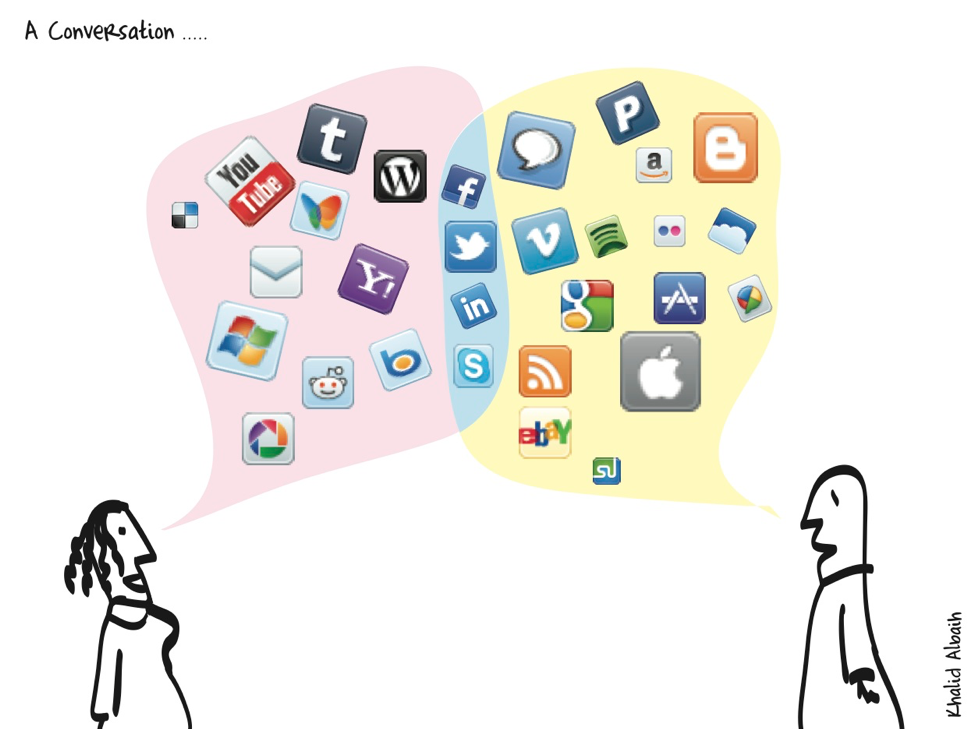In this section, we will be discussing how communication is used to meet needs; exists on multiple levels; is a transactional process; is situated; can be either face-to-face, mediated, or both; is continuous, intentional, and unintentional; and is irreversible.
1.3.1: Communication Meets Needs
In addition to using communication to exchange messages and create shared meaning, we also use it to meet the various needs we have as human beings. Communication meets four needs: physical, instrumental, relational, and identity.
Physical needs include needs that keep our bodies and minds functioning. Communication, which we most often associate with our brain, mouth, eyes, and ears, actually has many more connections to and effects on our physical body and well-being. At the most basic level, communication can alert others that our physical needs are not being met. Human beings are social creatures, which makes communication important for our survival.
Instrumental needs include needs that help us ‘get things done’ in our day-to-day lives and achieve short- and long-term goals. We all work towards short- and long-term goals every day. Fulfilling these goals is an ongoing communicative task, which means we spend much of our time communicating for instrumental needs. Some common instrumental needs include influencing others, getting information we need, or getting support (Burleson, Metts, & Kirch, 2000).
Communication meets our relational needs because it is through communication that we begin, develop, maintain, and end relationships. In order to develop a relationship, we may use nonverbal communication to assess whether someone is interested in talking to us or not, then use verbal communication to strike up a conversation. Then, through the mutual process of self-disclosure, a relationship forms over time. Once formed, we need to maintain a relationship, so we use communication to express our continued liking of someone. We can verbally say things like “You’re such a great friend.” Finally, communication or the lack of it helps us end relationships. We may communicate our deteriorating commitment to a relationship by avoiding communication with someone, verbally criticizing him or her, or explicitly ending a relationship. From checking in with relational partners by text, social media, or face-to-face, to celebrating accomplishments, communication forms the building blocks of our relationships.
Identity needs include our need to present ourselves to others and be thought of in particular ways. Our identity changes as we progress through life, but communication is the primary means of establishing our identity and fulfilling our identity needs. Communication allows us to present ourselves to others in particular ways. Just as many companies, celebrities, and politicians create a public image, we present different faces in different contexts. The influential scholar Erving Goffman compared self-presentation to a performance and suggested we all perform different roles in different contexts (Goffman, 1959). For example, you may perform the role of a parent when at home with your child, but the role of supervisor when at work.

Communicating Identity: Communication allows us to express our identities, both verbally and nonverbally. Our physical appearance, such as clothing choices, grooming, accessories, and body art, enables us to present an image of ourselves to others.
1.3.2: Communication Exists on Multiple Levels
Communication operates on two distinct levels: there is a content dimension and a relational dimension. The content dimension is the meaning of the actual message itself, whereas the relational dimension expresses “how you feel about the other person: whether you like or dislike the other person, feel in control or subordinate, feel comfortable or anxious, and so on” (Adler, 2017, p. 18). For example, consider the difference between someone saying “I’m busy tonight” in an annoyed tone versus “Sorry babe, I’m busy tonight” in an apologetic tone. Both messages mean the same thing on the content dimension, but express different feelings on the relational dimension. There may be times when the content dimension is all that matters; likewise, there are other times where more importance is placed on the relational dimension (Adler & Proctor, 2017).
1.3.3: Communication is Transactional
Communication is also a transactional process, this means that: 1) Each communicator is simultaneously a sender and receiver of messages. 2) Meaning is co-created in the interaction by both communicators. 3) Communication is an ongoing process and previous interactions between communicators influence current interactions. And since communication is ongoing, 4) current interactions likewise will influence future interactions and will either affirm or modify perceptions of the other and the relationship (Alberts, Nakayama, & Martin, 2016).
1.3.4: Communication can be Face-to-Face, Mediated, or Both
Communicative interactions can take place face-to-face using verbal symbols, such as words, and nonverbal symbols, such as gestures. They can also take place through a mediated platform, such as a smoke signal, email, or text message. Sometimes, it can even be a combination of face-to-face and mediated, such as when a speaker is presenting to an audience with a microphone. How the interaction takes place will affect how messages are produced, interpreted, and coordinated.

(Image: Khalid Albaih,CC BY 2.0)
Communication Channel: Our communicative interactions can take place face-to-face and through mediated-platforms, such as text message or social media. The channel we use to communicate is important as there are nuances that coincide with each which influence meaning.
1.3.5: Communication is Situated
All communication is situated, which means that communication occurs within a specific setting “that affects how the messages are produced, interpreted, and coordinated” (Verderber, MacGeorge, & Verderber, 2016, p. 16). Not only do the contextual factors mentioned in Section 2 influence communication, but communication is also situated historically, economically, socially, and politically. For example, some current political rhetoric surrounding Mexican immigrants paints them as criminals and rapists; this can affect how others perceive and communicate (or avoid communicating) with people that fall into this group.
1.3.6: Communication is Continuous, Intentional, & Unintentional
In all communicative interactions, we are continuously sending messages, whether they are verbal or nonverbal, and whether it is intentional (conscious), or unintentional (unconscious). Although communication may seem like a perceptible and deliberate process, we often send messages without conscious thought. In fact, there are so many messages being sent at one time that many of them may not even be received.
Additionally, not all behavior is consciously encoded. For example, we might have had a rough night with little sleep, which us yawn more often than we normally would. We are not deliberately and consciously encoding the yawn, rather our body does it without forethought. However, our yawn may unintentionally communicate “boredom” to the other person in the interaction. In contrast, a we may consciously decide to communicate a particular message (encoding) to another person if their story has gone on a very long time and we have somewhere else to go. We may decide in our heads that we need a way out of the conversation and consider a yawn and a glance toward the door to be an effective way to hint that we have to leave.

1.3.7: Communication is Irreversible
Once something is communicated, it is irreversible and cannot be un-communicated. While we “may try to qualify, negate, or somehow reduce the effects… once it has been sent and received, the message itself cannot be reversed” (DeVito, 2014, p. 25). Have you ever put your foot in your mouth and said something you wish you could take back? You may have even quickly said “I take it back,” but the impression created in the mind of the other cannot be erased. While we can apologize, there can still be consequences of the original message. This principle is also important to note in mediated-communication that takes place through platforms such as email or a text message, as your interactions can also be saved and shared with others.

(Image: Derick Anies, Unsplash)
Communication is Irreversible: The principle communication is irreversible reminds us that there are no ‘take backs’ when it comes to what we say and do. This is important to keep in mind when communicating through technology, such as phones, as what we say can be saved and easily shared with others.